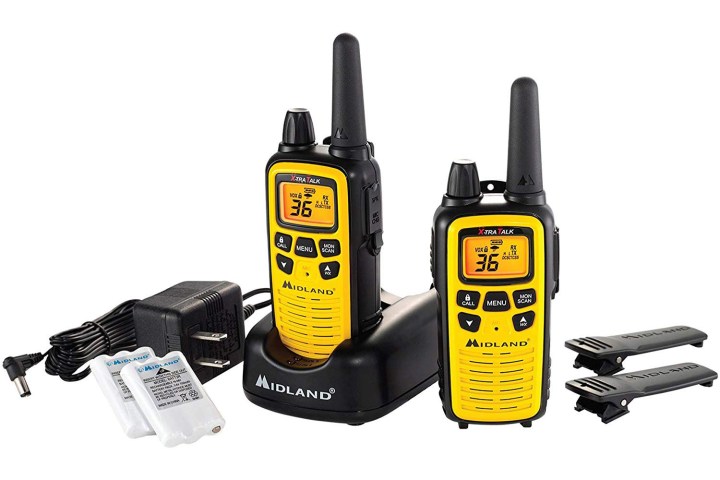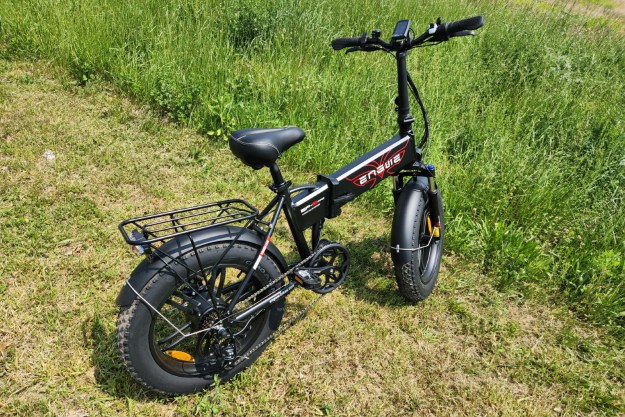Are you planning to spend some time in the backcountry, either hiking, camping, skiing, or simply enjoying the great outdoors? You still need some way to communicate. Cell phones aren’t a reliable option: even in today’s connected world, it is difficult to find service in remote locations. So how can you communicate effectively with the rest of your group and the outside world when something goes wrong?
One option is the satellite phone, which will work anywhere as long as you have a clear view of the sky. But these phones are expensive, as are the monthly service fees. Thankfully, there are much cheaper options out there. Good old-fashioned two-way radios (aka walkie-talkies) remain an efficient and affordable option for off-grid communications. There are hundreds of models to choose from, most of which won’t break the bank. After researching various sites and reading dozens of customer reviews, we’ve selected some of the best below.
Baofeng UV-5R

Only a decade ago, nobody had ever heard of BaoFeng. However, today the company’s radios are some of the bestselling (and best-reviewed) radios on Amazon. The UV-5R is one of the company’s discontinued models, but it has continued to sell on Amazon for rock- bottom prices and has become a favorite among amateur radio operators as a cheap handheld radio. It can both receive and transmit on any frequency between 136-174 MHz and 400-520 MHz at up to five watts of power, as well as receive between 65-108MHz. Other features include dual-frequency monitoring and standby and a built-in emergency alert siren.
With this particular radio, with no channels like most of the rest of our recommendations, you will need to ensure you have the proper licensing (if necessary) to transmit. But we can’t say enough good things about this radio, as it is a surprisingly good radio for the price.
Midland GXT100VP4
Midland has been making two-way radios for decades, but it’s always finding new ways to innovate. The GXT1000VP4 is a great example: it features 50 channels, 142 privacy codes, and an impressive 36-mile range. It sports a bright, backlit LCD screen, offers 10 customizable alerts for incoming messages, and includes a whisper mode for communicating in quiet situations. These walkie-talkies are also rugged, waterproof, and come with rechargeable battery packs that can keep them operating for hours at a time.
Beyond the basic functionality, Midland designed the GXT1000VP4 for use in emergencies. An SOS siren alerts others when help is needed, and a built-in NOAA weather alert radio keeps users ahead of severe weather. Midland even ships the radios with boom microphones for hands-free communication.
Motorola T100 Series Talkabout
Rather than shell out a lot of money for cell phones, some parents purchase a pair of inexpensive walkie-talkies to stay in contact with their kids instead. The Motorola T100 Talkabout is a great option for a number of reasons, not the least of which is a decent range. This device lets you communicate over a theoretical range of up to 16 miles, but our experience found them to work best when less than five miles apart.
These two-way radios offer good sound quality, a bright LCD screen, call tones, and 22 channels to chat on in a radio that is easy to use. A keypad lock prevents accidentally changing the settings. The T100 also has great battery life: you’ll get an impressive 18 hours of talk time out of a single set of three AAA batteries. Don’t worry about breaking the bank either — a set of three sets you back less than $50, and often much less during sales.
Midland X-Talker T20X4
Another kid-friendly option is the Midland X-Talker T20X4, a colorful four-pack of ruggedized GMRS/FRS radios. The T20X4s support the standard 22 license-free GMRS and FRS channels, with a scanning feature to check for activity on all channels. The radios also support CTCSS to block out other conversations, and voice-activated operation so that you don’t need to worry about pressing the PTT button to talk. Another great feature is built-in NOAA Weather Alert, which scans local weather radio channels to alert you to severe weather before it strikes.
While Midland claims a range of 16 miles, you’ll get the best results as long with a mile or two range. The “stubby” antenna on the device is to blame here; it isn’t the best for long-range communication. If you’re looking for something to communicate over longer distances, look elsewhere. For walkie talkies for the kids to play with, these are a great option, though. Just be ready for the kids to fight over which color they want.
ArcShell AR-5

They aren’t the prettiest radios in our roundup, but the ArcShell AR-5 rechargeable radios are by far the most economical if you’re looking to set up a larger group for communication. For less than $70, you’ll get six radios, all of which come with an earpiece and recharging dock. The radios operate on 16 pre-programmed channels in the 400-470MHz band, but you can set custom channels within that frequency band, too. While the earpiece is the best way to use these radios in noisy environments, the speaker is plenty loud, and voice activation allows to transmit without the need for pressing the push-to-talk button.
Given the deal here, some drawbacks may affect your decision. The AR-5 only has a maximum transmitting power of three watts, which reduces its range quite a bit from other models we’ve suggested. Buyers report solid performance under a mile, and ArcShell says in unobstructed conditions, the AR-5’s range maxes out at around five miles or so. It also has a shorter battery life and takes a while to recharge. Heavy use can kill the battery in as little as eight hours, and it takes two to three hours to charge a completely dead battery. But if you understand and can work around those limitations, it’s a heck of a deal.
BaoFeng BF-F8HP
If you are looking for power, look no further than the Baofeng BF-F8HP. The F8HP is an upgraded version of BaoFeng’s popular UV-5R radio, which created the market for low-cost, high-powered radios. The new BF-F8HP boasts of a whopping 8 watts of power as compared to the 2W or less of most FRS radios.
With power comes complexity, and the Baofeng BF-F8HP is not your average, easy-to-use walkie talkie. It is a full-fledged ham radio with the ability to broadcast on the public FRS channels. Some people purchase these radios to use unlicensed on FRS bands because they want a rugged, durable radio. Ham radio enthusiasts appreciate the versatility of a radio that can transmit on FRS as well as GMRS and ham radio bands. If you want to use the full power and features of the F8HP, then you need to obtain a ham radio license or a GMRS license, or both.
Midland LXT630VP3

The Midland LXT630VP3 makes our list as one of the top FRS radios sold on Amazon right now. They come full of features including 36 channels, a belt clip, fast charging, and a range of up to 30 miles according to the manufacturer. The bright yellow faceplate makes it easy to find, and the ruggedized outer shell is perfect for use anywhere. It even includes weather alerts to alert you when severe weather is nearby. Easy Voice and Sound Activation Transmission (eVOX) with three sensitivity levels makes hands-free operation a breeze.
Buyers laud these radios for its impressive audio quality and range (although like with any of these radios, under 10 miles seems to work the best). While this radio package only offers two radios and is a bit more expensive than most other options we’ve listed, we think the performance makes them worth the money.
What is GMRS/FRS and Amateur Radio?
We’ve presented radios that operate on a variety of radio frequencies and services. But what are these various radio services, and do you need a license for them? It depends on the frequencies and channels you use.
FRS stands for Family Radio Service and operates between 462-467 MHz. The technology owes its existence to Radio Shack, which successfully lobbied the Federal Communications Commission in the 1990s to allow manufacturers to produce radios with preset channels within that frequency band. The change permitted walkie-talkies to have exceptional range, with far less interference. Users are limited to a power of two watts on these channels, and there is no license required to use these frequencies. Channels 8 through 22 on your radio are FRS frequencies.
(Editor’s note: Some radios have additional channels, but these are not official FRS or GMRS channels. The radios will still be able to communicate on the official channels, however.)
GMRS stands for General Mobile Radio Service, and is like an FM version of the CB radios of the 1970s and 1980s. Much higher power outputs are permitted — up to 50 watts — which results in much longer ranges. You cannot use these channels or GMRS equipment without a license –that costs $70 and is good for 10 years. With the license, you’ll also be able to use eight repeater channels located on channels 23-30, which allows you to use the radio for conversations beyond “line of sight.”
Finally, Amateur Radio offers a group of frequencies from shortwave to microwave that requires you to pass a series of tests to gain access to more and more frequencies. Thankfully, you’re only required to take and pass one test to use the frequencies that these handheld radios operate on. The advent of FRS and GMRS has made it unnecessary to get your ham radio license (some ham radio channels are quite close to the FRS/GMRS frequencies), but ham radio frequencies are far less crowded and it’s easier to find a clear frequency to communicate than either FRS or GMRS, especially in more urbanized areas.
How to choose the right walkie-talkie
Selecting the right walkie-talkie for your needs is pretty simple — it all comes down to how you plan to use it. The vast majority of us will do just fine with FRS radios as we’re never straying too far from others that we might be communicating with. They’re also the cheapest radios, too. However, those exploring the backcountry might be better served by a longer-range GMRS walkie-talkie.
While you’ll pay $70 for the license, it’s good not only for you but for your immediate family. We think the added range of these radios is worth the licensing costs, especially if you plan to use them frequently in heavily wooded or mountainous areas. You’ll need all the power you can get to get a signal out in those areas. If you’re an amateur radio operator (or may be interested in becoming one), the BaoFeng handhelds we’ve recommended are excellent options.
Editors' Recommendations
- The best electric bikes for 2023
- The best mountain bikes
- Grab a great offseason deal on the best snowboards
- The best smart helmets for 2019
- The best backpacking sleeping bags for 2019





